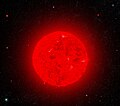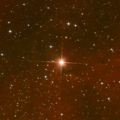Mu Cephei

Mu Cephei, also known as Herschel's Garnet Star due to its red, garnet-like color, is a red hypergiant star in the Cepheus constellation. With a radius between 1,260 and 1,420 solar radii,[1][2] or a diameter between 1.7 and 2 billion kilometers, it is one of the largest stars known. This means Mu Cephei is twice the size of the more famous star Betelgeuse.[3] Mu Cephei is also 269,000 times brighter than the Sun.[4] Mu Cephei is also the "prototype" of the semiregular variable star type.
Mu Cephei Media
1785 portrait of William Herschel
Zooming to the μ Cep (Garnet star) in the constellation Cepheus.
Mu Cephei (circled) as can be seen in binoculars. The bright star on the right is Alderamin (Alpha Cephei).
Mu Cephei and surrounding nebulosity, imaged at H-alpha and OIII wavelengths (north is towards top left)
A visual band light curve for Mu Cephei, adapted from Brelstaff et al. (1997)
Related pages
References
- ↑ Kravchenko, K.; Chiavassa, A.; Van Eck, S.; Jorissen, A.; Merle, T.; Freytag, B.; Plez, B. (December 2019). "Tomography of cool giant and supergiant star atmospheres II. Signature of convection in the atmosphere of the red supergiant star $\mu$ Cep". Astronomy & Astrophysics. 632: A28. arXiv:1910.04657. doi:10.1051/0004-6361/201935809. ISSN 0004-6361.
- ↑ Emily M. Levesque1 et al 2005. "The effective temperature scale of galactic red supergiants: cool, but not as cool as we thought" Astrophysical Journal 628, 2. [1]
- ↑ Mittag, M.; Schröder, K.-P.; Perdelwitz, V.; Jack, D.; Schmitt, J. H. M. M. (2023-01-01). "Chromospheric activity and photospheric variation of α Ori during the great dimming event in 2020". Astronomy & Astrophysics. 669: A9. doi:10.1051/0004-6361/202244924. ISSN 0004-6361.
- ↑ Davies, Ben; Beasor, Emma R. (2020-03-21). "The 'Red Supergiant Problem': the upper luminosity boundary of type-II supernova progenitors". Monthly Notices of the Royal Astronomical Society. 493 (1): 468–476. arXiv:2001.06020. doi:10.1093/mnras/staa174. ISSN 0035-8711.






